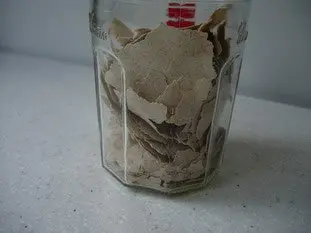This site uses only a few technical cookies necessary for its operation. By continuing to browse, you accept their use.
To find out more...
To find out more...
Natural leaven (Slideshow version)
Stage 11/11 :
Break the crust into small pieces, and store in an airtight container. These leaven pieces will keep almost indefinitely.To start the leaven again, put some pieces in the same weight of water, dissolve, then add some flour and it will come back to life.
Remarks
The leaven is alive and "feeds" on the exterior part of the grain so it's necessary to use "whole" or brown flours, like rye flour or wholemeal wheat flour rather than a very refined white one (like the French Type 45 or 55). It's much easier to succeed using leaven with a rye flour.In theory a leaven is everlasting: you feed it, you use a little, and so on; but sometimes there's a drama: it "dies", and you need to start the whole process again.
Precautions:
Leaven is very sensitive to the environment, so it's necessary to avoid:
- Any contact with detergents or similar chemical products, you must rinse all utensils thoroughly.
- Low temperature, its preferred temperature is 26°C or 79°F.
- Contact with chlorinated water, you should use spring or filtered (Brita kind) water, and warm.
To store it, use a container which lets some air pass, and keep it in a warm place. The best place is normally high up, like on top of a wall cupboard in the kitchen for example.
The leaven is nourished by the outer envelope of the grain, so it's very important to use a flour with a high germ and bran content. This recipe is based on standard rye flour T170 which gives very good results. You can also consult some information on flours.
There is not one, but several leaven recipes, each one having its own little tricks, tips, additions, and peculiarities. This recipe is a "soft" or "liquid" leaven, id you want "hard" leaven you should simply double the weight of flour.
If you'd like more information, you can consult this special page on making your own bread.
Some tips:
When leaven is started, it's necessary to manage it, i.e. refresh it "when necessary" to obtain the right weight of leaven at the time you need it (typically, the day before you make leavened bread). It's not easy to succeed, especially in the at first when there's an annoying tendency to make too much, and it is very sad to have to throw some away.
Bear in mind that with each "refreshing" the leaven triples its weight, which quickly builds up. If you only make bread (like me) on Saturdays, you should ask yourself the question: how much leaven do I need to make my final leaven Friday evening? and starting from this weight (to which you should add another 30/40 g to be on the safe side), calculate for one refreshing on Wednesday and another on Monday.
All these calculations can be summarised in the following table by supposing that you need 540 g leaven on Friday evening (of course these proportions should be adapted to your needs). You should have a little left over (40g), not kneaded into the bread, which will be the base for feeding the following week and so on.
| Refreshing day | Monday | Wednesday | Friday |
|---|---|---|---|
| Leaven weight obtained after refreshing | 60g | 180g | 540g |
| Soit | 3 x 20 g | 3 x 60g | 3 x 180g |
Some common problems, and some solutions:
Q: A veil of liquid formed on the surface of the leaven, what can I do?
R: Your leaven has waited too long before being refreshing. Mix until homogeneous, then refresh as usual.
Q: My leaven smells strong, is it normal?
R: It means that it is "hungry", it should be refreshed.
Q: Mould has appeared on the surface of the leaven, what can I do?
R: Your leaven is dead. Start a new batch.
Q: Is it really necessary to feed the leaven before making bread?
R: Yes, if not your loaves will not rise properly.Checklist for leaven that will not start:
Your leaven won't start, it has been tragically flat for more than 3 days, or it's gone mouldy? Give up on that one, throw it out and start a fresh batch, paying attention to these essential points:
- Are you using organic rye flour? Organic quality guarantees you the absence of fungicides or other chemical products which could kill your young leaven.
- Are you using spring water? (chlorinated water could kill your developing leaven)
- Have you put it in a container which was carefully rinsed with hot water? (any traces of detergent could disrupt your young leaven)
- Are you keeping it in a warm place? (too low a temperature would prevent your leaven from "starting")
- Are you allowing the container to air, just covering it with a damp cloth? (It is necessary for the helpful yeasts bacteria in the air to "seed" your water and flour mixture)
